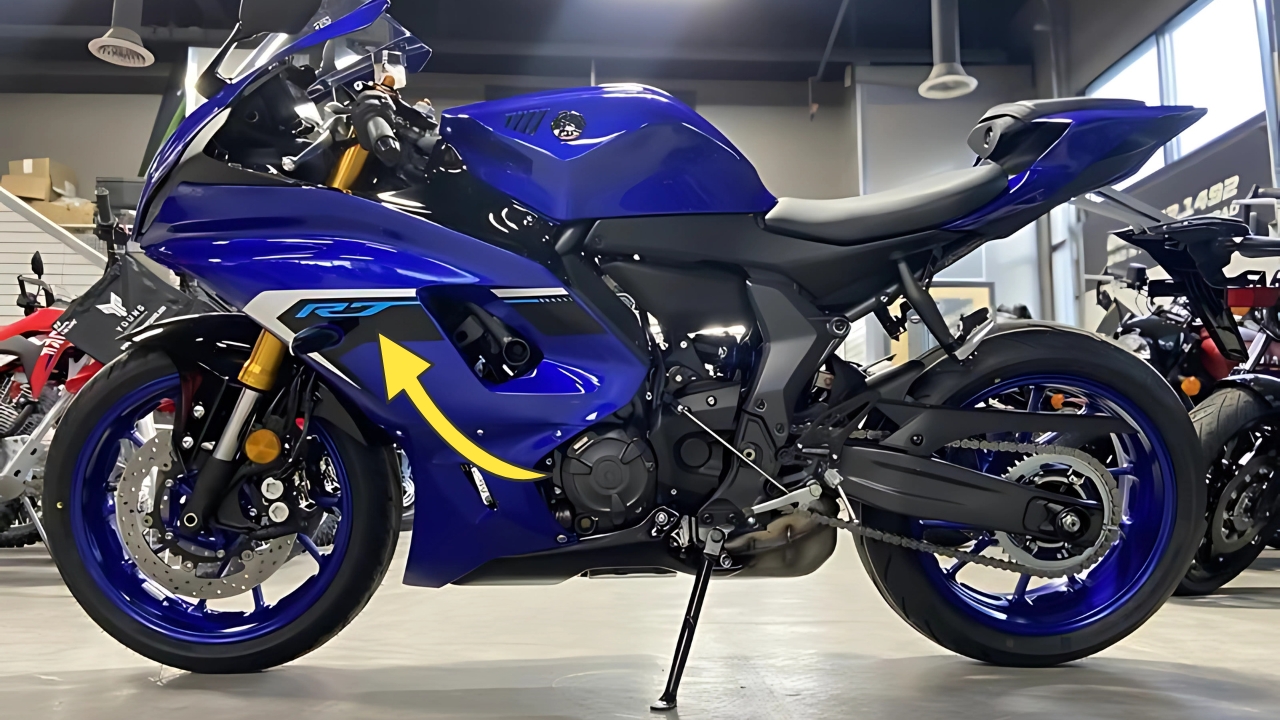Yamaha R7 : The motorcycle world witnesses the resurrection of an iconic nameplate with the Yamaha R7, though this modern interpretation takes a different approach than its legendary predecessor.
This comprehensive review explores how Yamaha has reimagined the R7 concept for contemporary riders, creating a machine that bridges the gap between track capability and street usability.
Yamaha R7 Design Philosophy and Aerodynamic Excellence
The new R7 embraces Yamaha’s current R-series design language with sharp, angular bodywork that serves both aesthetic and functional purposes.
The front fairing incorporates M1-inspired aerodynamics, channeling air efficiently while creating downforce at higher speeds.
LED headlights integrate seamlessly into the aggressive nose section, maintaining visibility without compromising the sporty silhouette.
The fuel tank design allows riders to tuck in effectively during spirited riding while providing reasonable comfort for street use. Side fairings flow smoothly from front to rear, managing airflow around the rider while showcasing the exposed frame sections.
The tail section maintains the sharp, truncated appearance characteristic of modern supersports.
Color schemes pay homage to Yamaha’s racing heritage, with the traditional blue variant echoing championship-winning liveries.
Alternative options provide personalization while maintaining the model’s sporting intent. Every surface demonstrates purpose-driven design that prioritizes performance over ornamentation.
Ergonomics and Riding Position
The R7’s riding position strikes a careful balance between track-focused aggression and street practicality. While committed, the ergonomics prove less extreme than pure race replicas, allowing extended riding without excessive discomfort.
The clip-on handlebars position naturally for sporty riding while maintaining reasonable wrist angles.
Seat design accommodates various rider sizes with adequate padding for street use.
The passenger accommodations remain minimal, clearly indicating the bike’s solo-focused intent. Footpeg positioning creates a sporty stance without being uncomfortably high, allowing confident control during aggressive riding.
The relationship between seat, handlebars, and footpegs creates a riding triangle that encourages active rider involvement.
This positioning proves particularly effective on twisty roads where frequent body position changes enhance control and feedback.
CP2 Engine Character and Performance
At the heart of the R7 lies Yamaha’s proven CP2 parallel-twin engine, derived from the MT-07 platform but refined for supersport application.
This 689cc crossplane engine delivers its characteristic torque-rich performance with linear power delivery that builds progressively through the rev range.
The engine’s character differs significantly from traditional inline-four supersports, offering abundant mid-range torque that proves particularly useful for street riding and corner exits.
Power delivery remains predictable and controllable, building confidence for riders developing their skills.
Refinement levels impress with minimal vibration despite the 270-degree crank configuration.
The exhaust note provides an engaging soundtrack that differs from typical parallel twins, with a distinctive growl that intensifies with revs. This auditory feedback enhances the riding experience without being excessively loud.
Chassis Dynamics and Handling
The R7’s chassis represents significant development beyond its MT-07 origins. The steel tubular frame receives reinforcement in key areas, increasing rigidity for improved handling precision.
Geometry changes optimize the chassis for sportier riding, with steeper rake angles and reduced trail enhancing agility.
Suspension components mark a major upgrade, with fully adjustable KYB inverted front forks providing excellent control and feedback.
The rear monoshock offers comprehensive adjustment options, allowing riders to optimize setup for their weight and riding style. This suspension quality typically appears in significantly more expensive motorcycles.
Braking performance comes from dual front discs with four-piston calipers, providing strong, progressive stopping power.
The master cylinder delivers excellent feel, allowing precise modulation during trail braking. ABS intervention remains unobtrusive, activating only when genuinely needed while permitting spirited riding.
Track Capability and Street Manners
The R7 demonstrates impressive versatility between track days and street riding. On circuit, the chassis composure and predictable power delivery create an ideal platform for developing riding skills.
The bike communicates clearly with riders, building confidence to explore limits safely.
Street behavior remains civilized despite the focused intent. The engine’s flexibility eliminates constant gear changes in traffic, while the riding position proves manageable for shorter commutes.
Heat management keeps rider comfort acceptable even in stop-and-go conditions.
The sweet spot emerges on twisty backroads where the R7’s balanced package shines. Quick direction changes feel effortless, while mid-corner stability inspires confidence.
The torquey engine pulls strongly from corner exits, making overtaking straightforward.
Technology and Features
While eschewing complex electronics, the R7 includes essential modern features. The LCD instrument cluster provides clear information including gear position indicator and shift light.
ABS represents the sole electronic rider aid, maintaining the pure, mechanical connection many riders prefer.
This minimalist approach reduces complexity and cost while ensuring riders develop skills without electronic intervention.
The absence of riding modes or traction control places responsibility on throttle control, creating a more engaging experience for skilled riders.
Value Proposition and Market Position
The R7 positions itself uniquely in the supersport segment, offering track-capable performance at accessible prices. By utilizing the proven CP2 platform with focused supersport development, Yamaha delivers exceptional value.
The high-specification suspension alone typically costs significant amounts as aftermarket upgrades.
Target riders include those seeking affordable track bikes, experienced riders downsizing from liter-class machines, and enthusiasts wanting engaging performance without extreme commitments.
This positioning avoids direct competition with four-cylinder middleweights while creating its own niche.
Yamaha R7 Conclusion
The Yamaha R7 successfully reimagines the supersport concept for modern riders.
Through thoughtful engineering, quality components, and focused development, it delivers an engaging riding experience that excels on both street and track.
While purists might miss the screaming four-cylinder engines of traditional supersports, the R7’s accessible performance and exceptional value create a compelling alternative.
For riders seeking genuine supersport experiences without the associated costs and extreme ergonomics, the R7 represents an intelligent evolution of the category.
